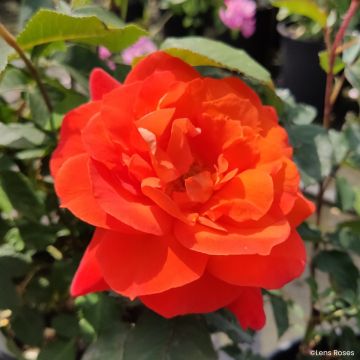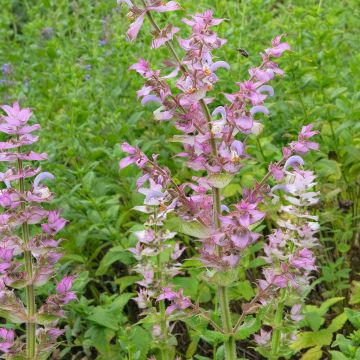

Dwarf Dahlia Collarette Dandy Mix Seeds
Dwarf Dahlia Collarette Dandy Mix Seeds
Dahlia variabilis Collarette Dandy
Dwarf Dahlia
2 PACKS BOUGHT SOWN AT RECEIPT RESULT 2 GERMINATIONS ONE PER PACK THAT MAKES IT EXPENSIVE FOR TWO FUTURE PLANTS NOTE 0.1 FOR THE SPEED OF DISPATCH AND 0 FOR THE GERMINATION POWER I WILL NOT ORDER ANYTHING AGAIN FROM PROMESSE DE FLEURS
guy, 07/04/2022
Special offer!
Receive a €20 voucher for any order over €90 (excluding delivery costs, credit notes, and plastic-free options)!
1- Add your favorite plants to your cart.
2- Once you have reached €90, confirm your order (you can even choose the delivery date!).
3- As soon as your order is shipped, you will receive an email containing your voucher code, valid for 3 months (90 days).
Your voucher is unique and can only be used once, for any order with a minimum value of €20, excluding delivery costs.
Can be combined with other current offers, non-divisible and non-refundable.
Why not try an alternative variety in stock?
View all →This plant carries a 6 months recovery warranty
More information
We guarantee the quality of our plants for a full growing cycle, and will replace at our expense any plant that fails to recover under normal climatic and planting conditions.
Would this plant suit my garden?
Set up your Plantfit profile →
Description
Dahlia 'Collarette Dandy' is a wonderful collection of bushy, dwarf dahlias with single, plain or bicoloured flowers in a wide array of shades including yellow, orange, red, pink and white. Each flower displays a dainty collarette, often in a contrasting colour. Planted en masse, they will be a great addition to any garden, no matter how small, as well as terraces or balconies. This improved selection is early flowering, blooming prolifically from July until the first frosts. Ideal for borders, growing to the front of flowerbeds or in pots.
Dahlias belong to the Asteraceae family and are native to Mexico. Nowadays, some 20,000 horticultural varieties are grown in gardens all over the world. 'Collarette Dandy' is a dwarf selection. The plants have a bushy, compact habit and do not require support, growing to approximately 55 cm in height and 30 cm in width. The flowering period takes place from July to October. The simple corollas are made up of a row of ray flowers in a variety of bright shades including yellow, orange, pink, red, and white, and of a row of small tapered petals surrounding the yellow central disc. Blooms are often two toned, in harmonious or contrasting shades. The stems are well branched and hollow, bearing opposite leaves that are subdivided into 3 or 5 toothed lobes. Both leaves and stems are dark green. To encourage repeat flowering and extend the flowering period, take care to remove faded flowers regularly. Better still, cut the flowers regularly to create beautiful, colourful arrangements.
Dahlias are great for creating patches of colour towards the front of summer beds and borders. They combine well with Echinacea, Helenias and Cosmos or with the soft, feathery plumes of ornamental grasses such as Pennisetum villosum. This dwarf variety is particularly suitable for growing in pots and containers on the patio or balcony.
Flowering
Foliage
Plant habit
Botanical data
Dahlia
variabilis
Collarette Dandy
Asteraceae
Dwarf Dahlia
Cultivar or hybrid
Other Thompson and Morgan seeds
View all →Planting and care
Sow in February-March, in seed trays or pots filled with sowing mix. Bury the seeds under 1.5 mm of fine soil. Place in a propagator or somewhere warm, at a temperature of 18 to 20°C. Germination takes 7 to 21 days. Transplant the seedlings into individual pots when they are strong enough to be handled, taking care not to damage the roots. Harden the plants off gradually and plant them out when all risk of frost is over, leaving 30 cm between each plant.
Dahlias enjoy full sun and rich, cool, well-drained soil. Stagnant humidity can cause the tubers to rot. If necessary, amend the soil with compost and sand. Dig over the plot thoroughly and enrich the soil with hoof and horn meal fertilizer. After planting, water once abundantly and repeat this regularly for the first 6 weeks to help root development.
Dahlias are sensitive to cold temperatures and must be overwintered indoors. In November, when the first frosts blacken the foliage, dig up the tubers carefully. Clean off as much soil as possible. Allow the foliage to dry, so that the tubers can rebuild their food reserves. Then cut the stems back to about 10 cm. Spread your bulbs in a crate on newspaper. Store them in a dry, cool, dark place, such as a garage or attic, sheltered from frost. In warmer climates, Dahlias can be left in place and protected under a layer of mulch (leaves, straw etc.)
Sowing period
Intended location
Planting & care advice
-
, onOrder confirmed
Reply from on Promesse de fleurs
Haven't found what you were looking for?
Hardiness is the lowest winter temperature a plant can endure without suffering serious damage or even dying. However, hardiness is affected by location (a sheltered area, such as a patio), protection (winter cover) and soil type (hardiness is improved by well-drained soil).

Photo Sharing Terms & Conditions
In order to encourage gardeners to interact and share their experiences, Promesse de fleurs offers various media enabling content to be uploaded onto its Site - in particular via the ‘Photo sharing’ module.
The User agrees to refrain from:
- Posting any content that is illegal, prejudicial, insulting, racist, inciteful to hatred, revisionist, contrary to public decency, that infringes on privacy or on the privacy rights of third parties, in particular the publicity rights of persons and goods, intellectual property rights, or the right to privacy.
- Submitting content on behalf of a third party;
- Impersonate the identity of a third party and/or publish any personal information about a third party;
In general, the User undertakes to refrain from any unethical behaviour.
All Content (in particular text, comments, files, images, photos, videos, creative works, etc.), which may be subject to property or intellectual property rights, image or other private rights, shall remain the property of the User, subject to the limited rights granted by the terms of the licence granted by Promesse de fleurs as stated below. Users are at liberty to publish or not to publish such Content on the Site, notably via the ‘Photo Sharing’ facility, and accept that this Content shall be made public and freely accessible, notably on the Internet.
Users further acknowledge, undertake to have ,and guarantee that they hold all necessary rights and permissions to publish such material on the Site, in particular with regard to the legislation in force pertaining to any privacy, property, intellectual property, image, or contractual rights, or rights of any other nature. By publishing such Content on the Site, Users acknowledge accepting full liability as publishers of the Content within the meaning of the law, and grant Promesse de fleurs, free of charge, an inclusive, worldwide licence for the said Content for the entire duration of its publication, including all reproduction, representation, up/downloading, displaying, performing, transmission, and storage rights.
Users also grant permission for their name to be linked to the Content and accept that this link may not always be made available.
By engaging in posting material, Users consent to their Content becoming automatically accessible on the Internet, in particular on other sites and/or blogs and/or web pages of the Promesse de fleurs site, including in particular social pages and the Promesse de fleurs catalogue.
Users may secure the removal of entrusted content free of charge by issuing a simple request via our contact form.
The flowering period indicated on our website applies to countries and regions located in USDA zone 8 (France, the United Kingdom, Ireland, the Netherlands, etc.)
It will vary according to where you live:
- In zones 9 to 10 (Italy, Spain, Greece, etc.), flowering will occur about 2 to 4 weeks earlier.
- In zones 6 to 7 (Germany, Poland, Slovenia, and lower mountainous regions), flowering will be delayed by 2 to 3 weeks.
- In zone 5 (Central Europe, Scandinavia), blooming will be delayed by 3 to 5 weeks.
In temperate climates, pruning of spring-flowering shrubs (forsythia, spireas, etc.) should be done just after flowering.
Pruning of summer-flowering shrubs (Indian Lilac, Perovskia, etc.) can be done in winter or spring.
In cold regions as well as with frost-sensitive plants, avoid pruning too early when severe frosts may still occur.
The planting period indicated on our website applies to countries and regions located in USDA zone 8 (France, United Kingdom, Ireland, Netherlands).
It will vary according to where you live:
- In Mediterranean zones (Marseille, Madrid, Milan, etc.), autumn and winter are the best planting periods.
- In continental zones (Strasbourg, Munich, Vienna, etc.), delay planting by 2 to 3 weeks in spring and bring it forward by 2 to 4 weeks in autumn.
- In mountainous regions (the Alps, Pyrenees, Carpathians, etc.), it is best to plant in late spring (May-June) or late summer (August-September).
The harvesting period indicated on our website applies to countries and regions in USDA zone 8 (France, England, Ireland, the Netherlands).
In colder areas (Scandinavia, Poland, Austria...) fruit and vegetable harvests are likely to be delayed by 3-4 weeks.
In warmer areas (Italy, Spain, Greece, etc.), harvesting will probably take place earlier, depending on weather conditions.
The sowing periods indicated on our website apply to countries and regions within USDA Zone 8 (France, UK, Ireland, Netherlands).
In colder areas (Scandinavia, Poland, Austria...), delay any outdoor sowing by 3-4 weeks, or sow under glass.
In warmer climes (Italy, Spain, Greece, etc.), bring outdoor sowing forward by a few weeks.






























































